Rupert Matthews's Blog, page 39
June 20, 2012
Early Christianity in Britain
Christianity came to Britain at least as early as 209, when a man named Alban was martyred in the town of Verulamium, now known as St Albans. The new religion made slow progress, though by 320 there were four bishops in Britain. We don’t know where they were based - though one was almost certainly in London - but the religion was one of townsfolk that had not yet reached rural areas such as Cornwall.
In 429 the church in Britain split from that on the continent. The secular government of Britain had left the Roman Empire 19 years earlier and that may have encouraged a more independent streak in the ecclesiastical authorities. The dispute erupted over the writings of the highly educated and much admired British monk Pelagius. As he grew older, Pelagius became more extreme. In 418 Pelagius was expelled from Rome by Pope Zosimus and his teachings condemned as heretical. Some of the finer points of Pelagianism can be obscure even to modern theologians, but the main thrust of his argument was clear enough. Pelagius argued that whether or not any particular human was to find salvation was a matter between that human and Christ. The human could help his cause through good works, charity and righteousness, but the final decision rested with God.
Of more practical importance, Pelagius stated that priests should teach their fellow humans about God’s grace and guide them along the right path, not to act as intermediaries between humans and God. Still less was the Church to be a hierarchy of bishops and archbishops with a bureaucracy and wealth of its own. This was in direct conflict with the developing doctrine of Papal supremacy developing in Rome. Zosimus and his followers claimed that humans could find salvation only through the intermediary of the Church headed by the Pope.
The split between Britain and Rome prompted Bishop Germanus of Auxerre to travel to Britain. He preached against the Pelagian views, championed in Britain by Bishop Agricola. Although he gained a good deal of support for maintaining links with Rome, Germanus failed to enforce orthodoxy. Next the Pope sent his own deacon, Palladius, to Britain. The official mission of Palladius was to convert the Irish, but he put most effort into an attempt to suppress Pelagianism. He failed, and died on his way back to Rome. His place as the head of the mission to the Irish was taken by the much more famous Patrick, a British Christian, who landed in Ireland in 432 and never left.
from MYSTERIOUS CORNWALL by Rupert Matthews.
Buy your copy HERE



In 429 the church in Britain split from that on the continent. The secular government of Britain had left the Roman Empire 19 years earlier and that may have encouraged a more independent streak in the ecclesiastical authorities. The dispute erupted over the writings of the highly educated and much admired British monk Pelagius. As he grew older, Pelagius became more extreme. In 418 Pelagius was expelled from Rome by Pope Zosimus and his teachings condemned as heretical. Some of the finer points of Pelagianism can be obscure even to modern theologians, but the main thrust of his argument was clear enough. Pelagius argued that whether or not any particular human was to find salvation was a matter between that human and Christ. The human could help his cause through good works, charity and righteousness, but the final decision rested with God.
Of more practical importance, Pelagius stated that priests should teach their fellow humans about God’s grace and guide them along the right path, not to act as intermediaries between humans and God. Still less was the Church to be a hierarchy of bishops and archbishops with a bureaucracy and wealth of its own. This was in direct conflict with the developing doctrine of Papal supremacy developing in Rome. Zosimus and his followers claimed that humans could find salvation only through the intermediary of the Church headed by the Pope.
The split between Britain and Rome prompted Bishop Germanus of Auxerre to travel to Britain. He preached against the Pelagian views, championed in Britain by Bishop Agricola. Although he gained a good deal of support for maintaining links with Rome, Germanus failed to enforce orthodoxy. Next the Pope sent his own deacon, Palladius, to Britain. The official mission of Palladius was to convert the Irish, but he put most effort into an attempt to suppress Pelagianism. He failed, and died on his way back to Rome. His place as the head of the mission to the Irish was taken by the much more famous Patrick, a British Christian, who landed in Ireland in 432 and never left.
from MYSTERIOUS CORNWALL by Rupert Matthews.
Buy your copy HERE


Published on June 20, 2012 03:39
June 19, 2012
Aussie VC with RAF Bomber Command
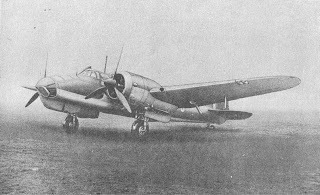
In one hectic week in July 1941 the airmen of Bomber Command in Norfolk were awarded two Victoria Crosses, the highest award for gallantry in action available. Both men came from the colonies, but otherwise were very different characters united only by their outstanding bravery in the face of the enemy.
Hughie Idwal Edwards had been born in Western Australia, the son of Welsh immigrants on 1 August 1914. At the age of 20 he joined the army to serve in the local artillery that protected the port from naval attack, but in 1935 transferred to the Royal Australian Air Force (RAAF) before joining the RAF the following year. In 1937 he began his flying career as a pilot on Blenheim MkI bombers with 90 Squadron. He was, therefore, an experienced professional by the time he was appointed to command 105 Squadron at Swanton Morley in May 1941.
Edwards led his squadron on several sweeps across the North Sea hunting for German ships before, on 4 July he was ordered to lead Operation Wreckage, an attack on the docks at Bremen. This was to be Edwards’ 36th operational flight and he was to have under his command not only 105 Squadron, but also six Blenheims from 107 Squadron. Edwards briefed his men to fly to Bremen in tight formation, but on arrival they were to form up into a line abreast, each aircraft some 400 feet apart from the others. Edwards hoped in this way to ensure that each aircraft found a worthwhile target while keeping to a minimum the chance that two bombers would go for the same victim. The attack was to be quick and destructive, with the Blenheims wasting no time before racing back out to sea towards England.
The formation flew over the sea at around 100 feet to avoid German radar, roaring over the coast at Cuxhaven. As soon as they were over land the aircraft were spotted and the air defences of Bremen soon began to throw up flak and machine gun fire. Edwards led his aircraft through the outer ring of defences and negotiated a field of barrage balloons before giving the order for the formation to form up abreast.
By this time Edwards had his Blenheim down to just 50 feet and only narrowly avoided hitting a telephone wire strung between a pole and an office building. Seconds later Edwards flew under an electricity power line before spotting a large factory. Turning slightly to get over the target, Edwards dropped his bomb dead on target. His navigator, Pilot Officer Ramsay, took a famous photograph looking back over the aircraft’s tail showing the factory just before it was torn apart by the bombs.
from HEROES OF RAF BOMBER COMMAND, NORFOLK by Rupert Matthews
Buy your copy HERE


Published on June 19, 2012 00:56
June 16, 2012
Bonnie Prince Charlie gets ready for the Battle of Falkirk
The Battle of Falkirk, the second to take place near the town, was the last victory for the Jacobites. The battle was fought in an atmosphere of growing political confusion, but the military victory seemed clear enough.
Having raised the standard of Jacobite revolt in the Highlands in 1745, Bonnie Prince Charlie quickly gathered an army of clansmen. At Prestonpans he crushed the English army sent against him and as a result gathered much support from the Scottish Lowlands. His march into England was halted when neither the expected French invasion nor the promised English Jacobite uprising materialised. After fighting a successful rearguard action at Clifton, the Jacobite army arrived in Glasgow on 26th December.
On his return to Glasgow, Prince Charles was delighted to find that the French had sent him reinforcements. These were not the professional troops that his army commander Lord George Murray wanted, but half a dozen heavy cannon. These guns were at once sent into the siege lines around Stirling Castle,which was still holding out after five months.
The pursuing English armies had meanwhile combined at Newcastle under a new commander, General Henry Hawley and was marching on Edinburgh. Learning of the new threat to Stirling, Hawley decided to march to the relief of the castle. Despite the successes of the clansmen at Prestonpans and Clifton, Hawley had little time for them. He knew all about their aggressive tactics but believed they could be crushed by well-trained men in a strong position under a good commander. He knew his army was composed largely of veterans and had no doubt that he was a superb leader. All he needed was to find the right position.
Unfortunately for Hawley, it was Murray who got into position first. About noon on 17th January Murray drew his army up on a ridge west of the town of Falkirk where he blocked Hawley’s route to Stirling. The Jacobite army was for a time confused when John O’Sullivan, the mercenary who acted as Prince Charles military adviser, disagreed with Murray about the army’s positioning. But Murray got his way and the army deployed as ordered.
From ENGLAND VS SCOTLAND by Rupert Matthews. Buy your copy HERE
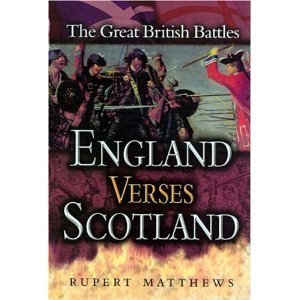


Having raised the standard of Jacobite revolt in the Highlands in 1745, Bonnie Prince Charlie quickly gathered an army of clansmen. At Prestonpans he crushed the English army sent against him and as a result gathered much support from the Scottish Lowlands. His march into England was halted when neither the expected French invasion nor the promised English Jacobite uprising materialised. After fighting a successful rearguard action at Clifton, the Jacobite army arrived in Glasgow on 26th December.
On his return to Glasgow, Prince Charles was delighted to find that the French had sent him reinforcements. These were not the professional troops that his army commander Lord George Murray wanted, but half a dozen heavy cannon. These guns were at once sent into the siege lines around Stirling Castle,which was still holding out after five months.
The pursuing English armies had meanwhile combined at Newcastle under a new commander, General Henry Hawley and was marching on Edinburgh. Learning of the new threat to Stirling, Hawley decided to march to the relief of the castle. Despite the successes of the clansmen at Prestonpans and Clifton, Hawley had little time for them. He knew all about their aggressive tactics but believed they could be crushed by well-trained men in a strong position under a good commander. He knew his army was composed largely of veterans and had no doubt that he was a superb leader. All he needed was to find the right position.
Unfortunately for Hawley, it was Murray who got into position first. About noon on 17th January Murray drew his army up on a ridge west of the town of Falkirk where he blocked Hawley’s route to Stirling. The Jacobite army was for a time confused when John O’Sullivan, the mercenary who acted as Prince Charles military adviser, disagreed with Murray about the army’s positioning. But Murray got his way and the army deployed as ordered.
From ENGLAND VS SCOTLAND by Rupert Matthews. Buy your copy HERE


Published on June 16, 2012 01:16
June 14, 2012
Propaganda and the Battlefield of Thermopylae

Xerxes
When the sun rose on 21 August 480bc, the battle of Thermopylae was over but the campaign still had some way to run. Xerxes, King of Kings, was determined to exact revenge on those who had stood against him and to continue with the original object of the invasion: the destruction of Athens and Sparta and the reduction of the rest of Greece to the status of a province of the Persian Empire.
First, however, there was some tidying up to do and propaganda to take care of.
Exactly how many of the Great King’s soldiers had been killed it is impossible to say. Herodotus puts the total at 20,000, but this is probably just a guess. What is beyond question is that the casualties suffered by the Persian army were many, far more than those lost by the League army that had fought under King Leonidas of Sparta. But Xerxes wanted to present this battle as a great victory. He kept the bulk of his army and navy away from the battlefield while gangs of workmen dug large pits and hurriedly heaved the majority of the Persian bodies out of sight.
Only then was the rest of the vast army allowed to march through the Pass of Thermopylae. They will have seen the spiked head of Leonidas beside the roadside, the bodies of his men and the far fewer visible bodies of the dead Persians. Relays of boats brought over men from the fleet to see the battlefield. Xerxes wanted the battlefield presented as a stunning Persian triumph in which the impudent Greeks had been crushed by the overwhelming might of the Persian host. The battlefield certainly looked that way, but far too many people knew the truth.
from THE BATTLE OF THERMPYLAE by Rupert Matthews
Get your copy HERE
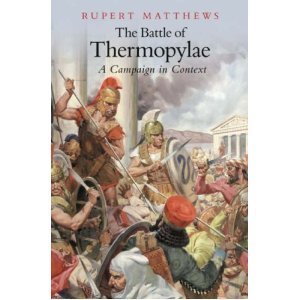

Published on June 14, 2012 01:35
June 12, 2012
What on Earth was the Duke of Parma doing as the Spanish Armada approached?
As the Spanish Armada sailed up the English Channel in 1588 its commander Medina Sidonia was beginning to worry about where Parma and his army was and what they were doing. He was, after all, supposed to link up with them to invade England. But he had had no news of Parma. Meanwhile, Parma himself was even more worried about what the Armada was up to. In the 16th century communications relied upon men carrying messages. They might carry written letters or verbal messages in their heads, but however they did so they had to physically go from one place to the other. This inevitably meant long delays and, in times of war, the constant danger that messengers might be captured by the enemy.
Parma was, in fact, at his central headquarters at Bruges, where he had been all along, not as Medina Sidonia had hoped down on the coast getting his troops ready to embark into boats. Historians have long argued over Parma’s behaviour during these crucial days in late July and early August. On the face of it his actions were quite bizarre.
This was recognised at the time and rumours abounded to try to explain things. Some whispered that Parma had fallen out with King Philip and was dragging his feet accordingly. It was said that some years earlier Philip had promised Parma that in the event of a Spanish conquest of England he would marry Mary Queen of Scots and so become Philip’s regent in England. Others said that Philip had gone so far as to promise the English crown to Parma in his own right. Now that Philip was going to give the crown to his daughter instead, men said, Parma was angry and saw no point in making much effort over the invasion.
Others suggested that Parma had been bought off by Elizabeth. It was rumoured that Elizabeth and the Dutch rebels had suggested to Parma that he should become independent Duke of the Netherlands - a throne to which he would have had a claim if his mother had not been illegitimate. The price demanded, men gossiped, was that Parma would have to allow freedom of worship to his subjects.
So far as we know neither of these scenarios had any foundation in fact at all. There is nothing in the records to indicate that Parma was anything other than unswervingly loyal to his royal uncle, Philip II of Spain. Nor is there much to show that he was less than a competent general, indeed one of the best of the 16th century. In fact it was probably this fact that explains Parma’s behaviour.
from "The Spanish Armada" by Rupert Matthews.
Buy your copy HERE
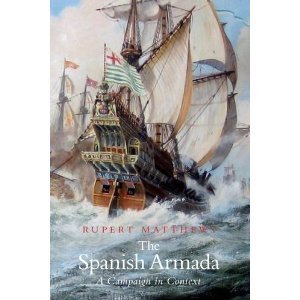


Parma was, in fact, at his central headquarters at Bruges, where he had been all along, not as Medina Sidonia had hoped down on the coast getting his troops ready to embark into boats. Historians have long argued over Parma’s behaviour during these crucial days in late July and early August. On the face of it his actions were quite bizarre.
This was recognised at the time and rumours abounded to try to explain things. Some whispered that Parma had fallen out with King Philip and was dragging his feet accordingly. It was said that some years earlier Philip had promised Parma that in the event of a Spanish conquest of England he would marry Mary Queen of Scots and so become Philip’s regent in England. Others said that Philip had gone so far as to promise the English crown to Parma in his own right. Now that Philip was going to give the crown to his daughter instead, men said, Parma was angry and saw no point in making much effort over the invasion.
Others suggested that Parma had been bought off by Elizabeth. It was rumoured that Elizabeth and the Dutch rebels had suggested to Parma that he should become independent Duke of the Netherlands - a throne to which he would have had a claim if his mother had not been illegitimate. The price demanded, men gossiped, was that Parma would have to allow freedom of worship to his subjects.
So far as we know neither of these scenarios had any foundation in fact at all. There is nothing in the records to indicate that Parma was anything other than unswervingly loyal to his royal uncle, Philip II of Spain. Nor is there much to show that he was less than a competent general, indeed one of the best of the 16th century. In fact it was probably this fact that explains Parma’s behaviour.
from "The Spanish Armada" by Rupert Matthews.
Buy your copy HERE


Published on June 12, 2012 01:26
June 6, 2012
A bloodless victory
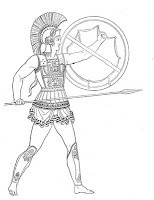
In ancient Greece, some phalanxes broke up even before battle was joined. At the Battle of Amphipolis in 422 the Spartans faced an Athenian army. The Spartan phalanx advanced with its customary discipline and determination. They halted to dress their lines, then gave their usual wild war shout. At the sound, the Athenians fled.
from "Alexander the Great at the Battle of the Granicus" by Rupert Matthews. Buy your copy HERE
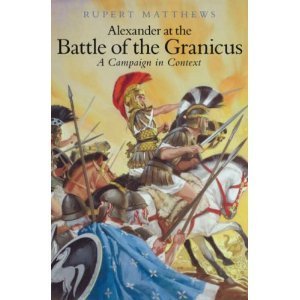

Published on June 06, 2012 23:28
June 2, 2012
The Battle of Crecy - intro
The Battle of Crecy changed everything.
This book tells the story of the most dramatic military
campaign of the medieval world. It has everything that a reader could want:
action, adventure, mystery and much more. As a story, it is thrilling. As an
exercise in exploring military history it is fascinating.
Before the Crecy campaign began, France was recognised to
have the greatest, most powerful and most modern army in all Christendom.
England was thought of as a prosperous but relatively backward kingdom lying
somewhere in the sea off the European coast. But six hours of bloodshed,
slaughter and heroism beyond imagining changed all that. The pride of France
was humbled, her army destroyed and her king made into a wounded fugitive
fleeing for his life through a foggy night.
This book explains to the general reader the reality of
warfare in the year 1346. It seeks to recreate in our minds the tactics used in
the Crecy Campaign and to put them into the context of the time. It shows what
the weapons were like and how they were used in action. It describes the
tactics of the different military units involved and how these would have
impacted on each other in battle. Crucially, it takes the reader inside the
minds of the commanders to explain what they did, why they did it and what they
hoped to achieve.
This is a gripping book that tells the thrilling story of a
campaign from long ago, bringing the thinking up to date and allowing the
modern reader to understand what it was really like to stand on a lonely
hillside in northern France alongside the King of England while the greatest
army in the world charged up the hill towards you. And to see with the King his
eldest son and heir knocked down by the enemy weapons. And when asked to send
help to the boy to hear King Edward refuse and say only:
“Let the boy win his spurs!”
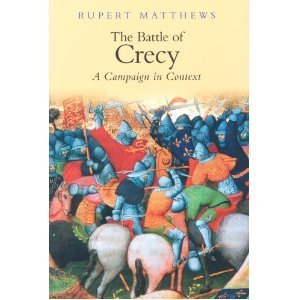
from "The Battle of Crecy" by Rupert Matthews. Buy your copy HERE

Published on June 02, 2012 05:05
May 31, 2012
Learning about RAF Bomber Command at War
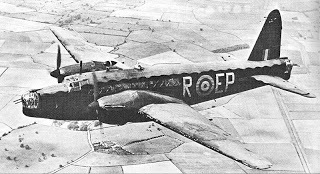
I don’t recall exactly how old I was, but I was at my
secondary school so I suppose I was in my teens. I was up in London with my
father for some reason and we had a bit of time to spare. My father said he had
something to show me, then led me down Fleet Street to a church.
That church was St Clement Danes, home church to the RAF.
Father opened the doors and walked in. I trotted along beside him, glancing
around at the flags, silver memorials and magnificent woodwork of the church,
but father had no time for such things. He strode past them all and headed
toward the pulpit. Just before reaching the pulpit he knelt down, scanning the
floor. He seemed to find something. Then he beckoned me over.
“Here it is,” he whispered. “See that.” He was pointing at a
small grey slate set into the floor. Only then did I look at the floor. It was
a mosaic of similar slates, each carved with a motif or crest.
“Battleaxe Blenheims”, said my father. “That’s what they
used to call us.” He was pointing at a slate on which was carved an axe inside
a circle with the numbers 105. He stood up. “That’s my old squadron crest. 105
Squadron, the Battleaxe Blenheims”. He glanced around the church. “All those
men, all those men. Thank goodness they have something to remind people of
their passing.” He looked at me. “Come on, son. Let’s go. I’ll buy you lunch”.
Then he took me to a restaurant off Fleet Street and for the
first time he began to tell me about his time with RAF Bomber Command at War.
from RAF BOMBER COMMAND AT WAR by Rupert Matthews
Buy your copy HERE


Published on May 31, 2012 01:26
May 29, 2012
Roman Executions
Perhaps the most unpleasant of all the events that took place in the Roman arena were the executions of the noxii, prisoners condemned to death by the magistrates. It is not just to modern sensibilities that the gruesome executions appear offensive, some Romans found them fairly repellent. For these were not straightforward public executions by beheading or hanging. Every refinement of cruelty and agony of which the Roman mind was capable was brought to bear on the noxii. And the Roman mind could be most imaginative.
Public executions were nothing unusual in the ancient world. In most societies they continued until just two centuries ago and in some countries continue today. The death penalty has been, and remains in many countries, the ultimate sanction of the state judicial system. For those crimes judged by society to be so terrible that there is no hope of redemption for the guilty person and in those places where the punishment ethic is strong, death is the only appropriate penalty. For some people certain crimes are so awful that the perpetrator must be destroyed and must be seen to be destroyed. Public execution is felt to be the ultimate sanction of society on its most anti-social elements.
For the Romans it became a public spectacle.
from THE AGE OF GLADIATORS
by Rupert Matthews
buy your copy HERE

Published on May 29, 2012 01:11
May 26, 2012
NEW BOOK Lambourn Valley Railway
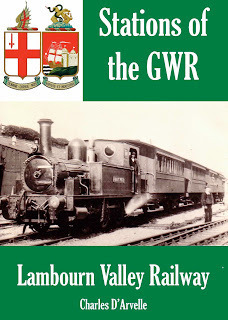
My good friend Charels D'Arvelle has a new ebook our - THE LAMBOURN VALLEY RAILWAY. This book
brings together all 9 of the books about individual stations on this
branch line.
A charming history of one of the long
closed rural branch lines on the Great Western Railway. The Lambourn
Valley was one of the most quintessentially English branch lines in the
days of steam.
The Lambourn Valley Railway was born as an independent little railway
that ran from Newbury up Berkshire’s scenic Lambourn Valley to Lambourn.
On the way it passed through 9 rural stations and ran through beautiful
countryside.
In this book we learn when the line was built and why. The impact the
railway had on the surrounding area is explained and the type of freight
and passengers that used the station are explained. We also learn about
the locomotives, rolling stock, directors, staff and equipment of the
railway line.
In 1905 the LVR was taken over by the GWR and the entire branch line was
upgraded and brought to GWR standards. The line remained open until
1964, but is now closed, the tracks lifted and the stations gone.
This book is a moving and thoughtful evocation of the days of steam.
The Lambourn Valley Railway is part of the Stations of the Great Western Railway collection published by Bretwalda Books
About the Author
Charles D’Arvelle is a railway enthusiast who has a particular
fascination with closed branch lines. He has spent many happy hours
tracing the locations of closed stations, abanoned sidings and lost
railway tracks. He declares it is a great way to get out and explore the
British countryside.
You can join the Facebook Page for these books HERE
You can buy the ebook HERE

Published on May 26, 2012 01:18























